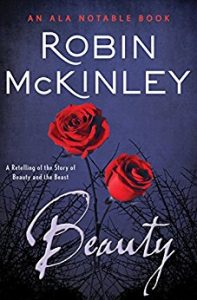
Robin McKinley
Open Road Media
Published on November 8, 2014 (Originally published October 25, 1978)

Amazon | Barnes & Noble | Goodreads
When Beauty’s family falls on reduced circumstances, she, her father, and two sisters move to a remote village rumored to be near an enchanted castle. Beauty and her sisters face their new lives bravely, learning to do chores and care for their new home. One night, after a long journey, their father returns home with a magical rose and a chilling story. He has met the Beast and ruler of the castle and now owes a debt: either his own life or the life of one of his daughters. Ever practical Beauty decides she must be the one to take her father’s place. But her new life in the castle turns out to be far different than anything she could have imagined. Invisible servants tend her needs, and the Beast, who seemed terrifying at first, soon becomes dear to her. A family emergency forces Beauty to choose: stay in the castle and let her sister make a terrible mistake, or risk everything to return home and warn her.
Beauty is one of the first young adult novels I ever read, and I happened upon it totally by accident in a used book stall at a flea market in the mountains of western North Carolina. I’ve since read other fairytale retellings by Robin McKinley, and have never been disappointed by any of them. Beauty used to be one of my go-to reads for those awful days when I was too sick to read and absorb something new, but still longed to escape reality in a book. It’s been years since I’ve read it, and still I couldn’t stop reading until I’d reached the end of the tale.
The style isn’t my favorite—it’s a lot more narrative than the kinds of books I usually prefer, but the descriptions are so vivid and Beauty’s character so clearly drawn that I always get sucked straight into the story anyway. This is a definite must-read for anyone who adores fairytale retellings. You’ll recognize a lot of familiar elements in other fairytales retold that authors drew from McKinley’s style and way of reimagining things. (In fact, one of my newer favorite authors who writes reimagined fairytales, Kenley Davidson, draws some inspiration from McKinley’s stories, and I think it’s one of the things that first drew me into her work.)
If you’re looking for clean young adult fiction, this is a great choice. McKinley has other books you might be interested in as well: Spindle’s End, her retelling of Sleeping Beauty; Outlaws of Sherwood, her retelling of Robin Hood; and her fantasy duo, The Blue Sword and The Hero and the Crown. I recommend them all.
Cultural Elements
Major characters are white and straight.
Profanity/Crude Language Content
None.
Romance/Sexual Content
A brief kiss and a few mentions of blushing or attraction.
Spiritual Content
A couple references to prayer. One character exclaims, “Merciful God.” The Beast’s castle is populated with invisible servants which Beauty often describes as a “breeze.” She begins to hear and understand them to be individuals as her time in the castle progresses.
Violent Content
None.
Drug Content
Wine is served with dinner.